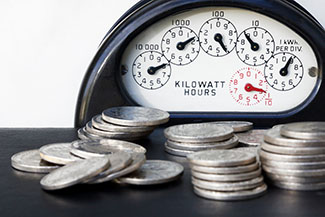Taming Your Electric Bill
 07 April 2020
07 April 2020 

Let's Get That Electric Bill Back In Shape
Working and schooling from home can make many families worry about their summer electric bill. With a little perseverance and flexibility there is hope that energy bills can be tamed.

Savings Plan
Taking some time to make sure you are on the right plan for your household, is the best place to start. Generally, optimum savings come from time of use and demand type plans. These plans, through both SRP and APS, divide energy into 2 categories 'on-peak and off-peak'. These plans charge based on when you use energy. Money is saved by shifting your homes electrical workload to off-peak hours. With a little planning, comfort does not have to be sacrificed. In addition to other resources, you will find a detailed article on choosing between plans on our website: Picking Your Power Plan
Taming The Biggest Energy Hogs In Your Home
Steve and Gina Koepp, owners of Advanced Home Systems, a Rosie on the House Certified Partner, tell us that the way to save is to pay attention to the big energy users. Steve says not to be too concerned with smaller items. For instance, 5 straight days of computer and router use would cost $1.01 at a rate of .14 cents per kWh. Gina says the air conditioning, water heater, oven, dryer and pool pump are the biggest offenders.

The key is to keep your demand low and to use major appliances during off-peak hours. The air conditioner is, of course, the hardest working appliance we own in the summer. One solution to the high cost of cooling is the method Rosie has dubbed, Super Cooling. To super cool the A/C is run as cold as the family likes (or colder) during off-peak hours while energy is plentiful and cheap. Once on-peak hours begin, the A/C thermostat is turned up to keep the unit from coming on, allowing the home to rely on the cooling from the morning. The hours considered to be on, and off-peak vary between utility companies. At SRP they are from 1:00pm until 8:00pm. At APS they are from 3:00pm until 8:00pm.
There are things that will help maintain cool air during on-peak hours:
- Minimize the number of times the door is open to the outside.
- Because dinner falls during on-peak hours, avoid heating up the house with heavy baking and cooking. Instead try to move cooking to the outside with the grill and experiment with recipes for the crockpot, microwave or even the stove top.
- Water heaters should be put on a timer to only produce hot water when needed.
- Run the washing machine, dryer, pool pump, and dishwasher during off-peak as much as possible.
The living adjustments aren't hard if you have the option of being flexible as you will need to plan your day around your energy consumption.
You can manage the demand yourselves - many people do. But to have the demand managed for you, consider purchasing an Energy Management System like Advanced Home Systems. With this unit, you choose your demand setting based on how well you can stagger activities and then the system monitors the usage. The system works to keep the demand down by not allowing your home to use energy that surpasses the set demand. You program the maximum desired demand load depending on the savings you want to achieve. Keeping your homes energy demand low by spreading out energy consumption offers the potential for big savings.
Save Dollars - Help Your Home To Help You!
Your savings will go further if your home is maintained for efficiency. Rosie's favorite energy saving tips are not expensive ones:
- Shade your windows and skylights. Create shade! There are a variety of choices available including sunscreens, tinting, vegetation, and awnings.

- Insulation. Make sure the attic has insulation that is adequate. Insulation that provides an R Factor of between 38-40 is ideal.
- Use your ceiling and floor fans. Remember, fans only cool the person, not the room. Don't waste energy by leaving them on in empty rooms.
- Change your air filters monthly. Replace them with 1" paper pleated filters every time you pay your electric bill.
- Caulk behind electrical plates. Secure the junction boxes to the wall material in all outlets and switches located on exterior walls.
- Repair loose weather stripping. Go outside on a hot day and feel around your doors and windows for cold indoor air that may be escaping.
- Ridge vent attic and insulation. Whirly birds or gable end vents are helpful as they allow warm air in the attic to rise up and out. But power ventilated vents are not a good choice as they suck the cooling out of your home.
- Use timers on your hot water heaters. Set the water heater to come on just when you need hot water so that the water heater is not heating water 24/7. The temperature can be set lower in the summer.
- Clean condensing coils. All appliances with compressors like refrigerators and freezers have coils that should be cleaned at least once a year. AC unit coils require cleaning once every 7-10 years.
- Clean your dryer vent at least once per year (if it is a vertical vent over 10' it should be cleaned quarterly)
Rebates Are Like Free Money!
SRP and APS have wonderful savings incentives and rebates for purchases that go toward energy upgrades. Here are a few of our favorites:
At SRP:
- Sun Screens: There is a rebate of .80 per sqft on professionally installed shade screens.
- Air Conditioning: A rebate up to $1,125 when you buy a new, energy efficient AC, mini split unit, or heat pump.
- Duct Work: up to $400 back for duct testing and qualified repairs.
At APS:
- Insulation: A $250 rebate when you insulate your home.
- Cool Control Device: Have one installed and receive $70
 Duct Sealing and Repair: $250 back for sealing up that leaky ductwork!
Duct Sealing and Repair: $250 back for sealing up that leaky ductwork!- NOTE: be sure to check requirements for each rebate – most must be performed by a licensed contractor.
Saving Cents
If you are not sure how much energy an appliance draws, APS offers a how-to that helps to determine the usage of different appliances. You could also invest in an electric usage monitoring device.
Once you have determined how much it costs to run an item you can decide how much time you will invest on saving money running that item.
There are actions that are just common sense and help avoid waste. Deciding what to eat before you open the refrigerator door is a great way to conserve energy and make it easier on your hard-working electric appliance. Shutting off unused lights, exhaust fans, and ceiling fans in addition to running full loads of dishes and laundry instead of half loads, can save on energy as well. SRP offers some great tips.
But remember, you can turn those cents saved into dollars saved by making sure your home is maintained to conserve energy. Follow Rosie's 10 tips to make your home more energy efficient as listed above. Couple these improvements and maintenance with the right price plan where you are actively using energy at the cheapest price and staggering your energy use, and you could be taking money to the bank.
###
Photo Credits: Shutterstock
RELATED CONTENT:
- Blog: Six Steps To Big Savings On Your Electric Bill
- Blog: Where Does Arizona Get Its Power?
- Blog: What is a mini-split AC system -- and what are the benefits?
- DIY FAQ: Picking Your Power Plan
- DIY FAQ: How To Save Money Every Summer By #SuperCooling
- DIY FAQ: Consumer Guide: How to Buy and AC System
- DIY FAQ: Maintaining your Heating and Cooling System
- DIY FAQ: Reading and Understanding Your Utility Bill
- Podcast: 9:00 AM Open Lines! Saving On Your Cooling Bill & Water Treatment
Print this page
recent post
- Duck, Duck, Duct! How Often Should Ductwork Be Cleaned?
- Vinyl vs. Fiberglass Windows: Which Is The Better Choice Of Replacement Window?
- We May Be The Grand Canyon State, But The Rocky Mountains Are Important For Arizona
- Welcome to Arizona! Things A Newbie to Arizona Should Know
- The Pros & Cons of Buying A Flipped House
- Getting In On The Ground Floor
- Why It’s More Critical Than Ever To Get Your AC Serviced Before Summer
- The Reality of Remodeling
- What To Look For When Comparing Your Roofing Quotes
- What To Expect When Buying New Windows & Doors
